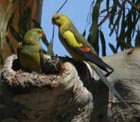 Ecologists from Charles Sturt University's (CSU) Institute for Land, Water and Society (ILWS) have joined forces with Australia's largest almond producer Select Harvests Limited to the look for ways to better manage agricultural landscapes to maximise production and conservation outcomes.
Ecologists from Charles Sturt University's (CSU) Institute for Land, Water and Society (ILWS) have joined forces with Australia's largest almond producer Select Harvests Limited to the look for ways to better manage agricultural landscapes to maximise production and conservation outcomes.The focus for the project is the Regent Parrot, a native bird which is endangered in NSW and only found in small pockets of River Red Gum and Mallee woodlands in NSW, Victoria and South Australia. Other populations also occur in the wheat-belt of Western Australia. At certain times each year, the parrot and other native birds feed on almonds causing significant production losses.
“It is no surprise to us to find an endangered species in an agricultural landscape, such as the almond cropping farms of Select Harvests,” said the Institute’s Dr Peter Spooner who heads the research team.
“Endangered species are not just found in national parks or patches of remnant vegetation. Often farm habitats can compensate for past tree clearing by providing food and other resources for a number of native species. A main aim of our research is to examine the positive and negative interactions between selected native species and the farming landscape around Robinvale in northern Victoria.”
The three year project is worth $1.4 million with CSU and Select Harvests Limited, which has provided $700 000 cash and in kind support - the major partners in the project. The project has received a $255 000 Industry Linkage Grant from the Australian Research Council, as well as $150 000 to fund a parallel project with the NSW Department of Environment and Climate Change. The Victorian Department of Sustainability and Environment (DSE) is also a major partner.
The research team includes CSU Associate Professors David Watson and Gary Luck; Environmental Manager for Select Harvests, David Valentine; Senior Biodiversity Officer with DSE Ian Temby; two PhD students from CSU who will study the Regent Parrot and the broader concept of sustainable agriculture and ways to maximise biodiversity gains; and a post-doctorate researcher who will develop landscape design criteria to benefit agricultural production and conservation aims.
The researchers will also study other birds found in a 10 000 sq km area around Robinvale and Euston, near Mildura, Victoria, which includes agricultural and natural landscapes and is a major food producing region for Australia.
Professor Watson said the team was looking for solutions to manage the needs of native species and agriculture.
“Cne way to manage the damage caused by the birds to the almond crop could be to plant other ‘sacrificial crops’ or reorganise the planting of trees,” he said.
“But first we need to better understand the ecology of the birds in farms. We need to find out more about Regent Parrots and develop realistic management guidelines.
“We will measure the value of almond plantations and other agricultural areas to native species generally. This is critical information for the long term management of Australia’s biodiversity.”
As part of the project Select Harvest employees are being trained to monitor bird occurrence in plantations and assist with studies of bird movements through the landscape. Professor Watson will run a two day training course on bird monitoring for 90 employees on Tuesday 28 and Wednesday 29 October at Robinvale.





Social
Explore the world of social